Three types of mustard are grown in Saskatchewan:
- Yellow mustard (Sinapis alba), also referred to as "white" mustard in some parts of the world;
- Oriental mustard (Brassica juncea); and
- Brown mustard (Brassica juncea).
Another type of mustard, Ethiopian mustard (B. carinata), has also been grown, but it has seen little activity in recent years.
Most canola grown in Saskatchewan is Argentine canola (B. napus). Some Polish canola (B. rapa) is also grown in the province.
A common question asked by growers, buyers and consumers of mustard is: "How can we differentiate canola from mustard?"
It is difficult to differentiate brown mustard seed from canola seed, even though brown mustard seed is smaller in size. Oriental mustard and yellow mustard seeds are yellow in colour.
There are also some differences in plant characteristics between mustard and canola types. The illustration below and the table on the next page provide some quick tips on how to differentiate the crops based on seed and plant characteristics.
| Canola (Brassica napus) |
Brown or oriental mustard (Brassica juncea) |
Yellow mustard (Sinapis alba) |
|
| Seeding | 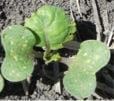 Heart-shaped cotyledons and leaf stalks are hairless. First true leaves have a hairless upper surface with scarce hairs on the underside of the leaf. |
 Heart-shaped cotyledons and leaf stalks are hairless. First true leaves are covered with hairs on both the upper and lower leaf surfaces. Hairs on leaves are less dense than on yellow mustard leaves. |
 Heart shaped cotyledons have a few hairs on the edges and upper surface. Stems and leaf stalks are densely pubescent (hairy). First true leaves have a dense covering of hair on both the upper and lower surfaces. |
| Adult Leaves |  Adult leaves are dark, bluish-green, waxy and either hairless or with a few sparse hairs near the leaf margin. The leaves will be rounded and will partially clasp the stem. |
 Leaves are pale green with hairs on the first leaves and leaf margins. The lower leaves will be deeply lobed, while the upper leaves will be narrower and not lobed. The leaf will terminate higher up on the petiole and will not clasp the stem. |
 Leaves are light-green, densely pubescent and deeply lobed. The leaf will terminate higher up on the leaf stalk and will not clasp the stem. |
| Flowers | 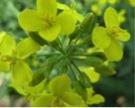 Yellow flowers with light yellow petals. |
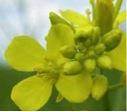 Pale yellow flowers. |
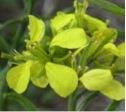 Yellow flowers that are smaller than canola's. |
| Stems | Hairless and smooth | Hairless and smooth | Pubescent with lots of small hairs on the stems and petioles. |
| Pods |  Long narrow pods with a smooth, medium conical peak. Pods are usually positioned at a right angle to the stem. |
 Smooth long, conical beaked pods. The pods are usually positioned 45º to the stem. |
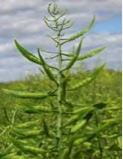 Pods are long, flat and covered with small hairs. Pods are positioned at a right angle to the stem. |
| Seeds |  Seeds are black in colour and spherical to oval in shape. They are larger than brown and oriental mustard, but smaller than yellow mustard seeds. |
 Brown Mustard Seeds are reddish brown to dark brown in colour and are 2mm or less in diameter. They have spherical or oval shape. |
 Seeds are light creamy yellow to yellow with the occasional seed being light or yellowish brown. The seeds will be spherical or oval in shape with a diameter of 2-3mm. |
 Oriental Mustard Seeds will be predominately yellow to dark yellow in colour with some seeds light brown to dark brown. They will be oval in shape with a width of 1.2 to 2.0 mm and a length of 1.6-3mm |
Contamination of mustard seed with canola/ rapeseed will result in downgrading. The maximum allowable limit for No.1 Canada grade in all three mustard types is 0.1 per cent. The maximum allowable limit for No. 3 Canada grade is 0.3 per cent.
To prevent the contamination of mustard with canola, never plant them on the same land. If this is not possible, allow a minimum of four years between Argentine canola and mustard, and six years between Polish canola and mustard. It is essential to control all wild mustard and volunteer canola plants in the crop(s) preceding mustard.
If purchasing mustard seed, inspect the seed tag. If using saved seed, have it analyzed for wild mustard and/or canola admixtures. Do not plant mustard seed that is contaminated with wild mustard or canola seed.
